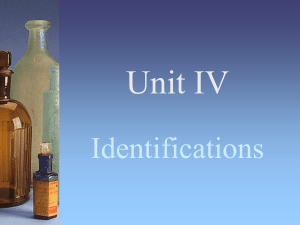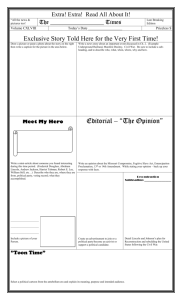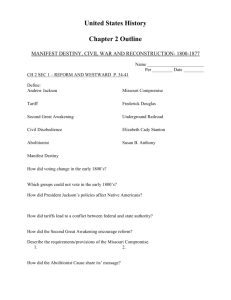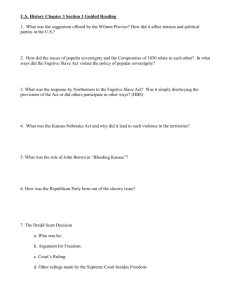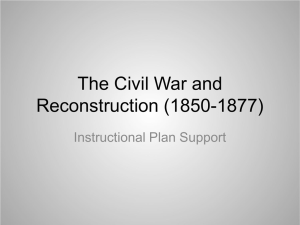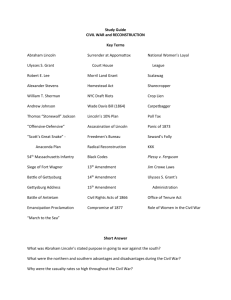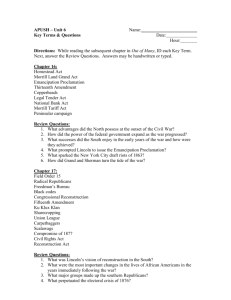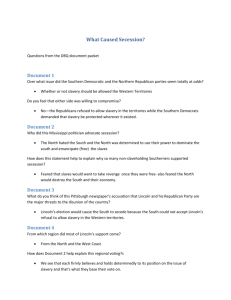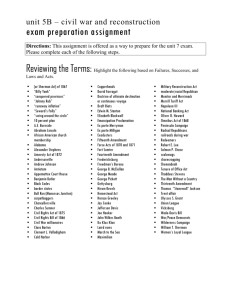Terms to Know Period 5
advertisement
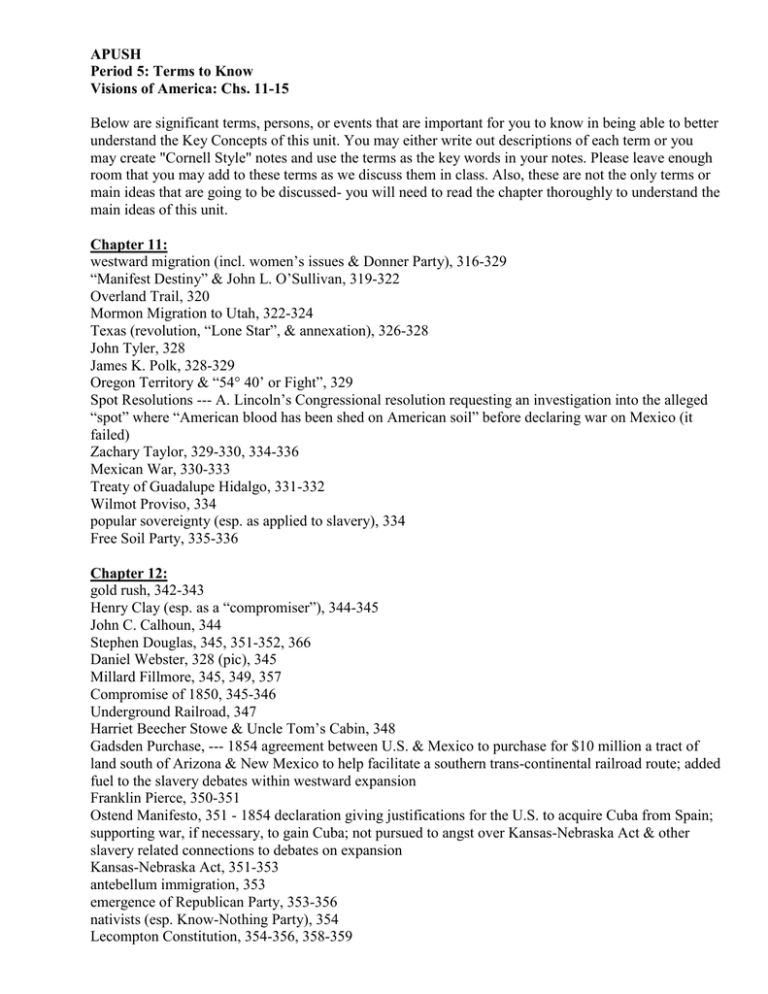
APUSH Period 5: Terms to Know Visions of America: Chs. 11-15 Below are significant terms, persons, or events that are important for you to know in being able to better understand the Key Concepts of this unit. You may either write out descriptions of each term or you may create "Cornell Style" notes and use the terms as the key words in your notes. Please leave enough room that you may add to these terms as we discuss them in class. Also, these are not the only terms or main ideas that are going to be discussed- you will need to read the chapter thoroughly to understand the main ideas of this unit. Chapter 11: westward migration (incl. women’s issues & Donner Party), 316-329 “Manifest Destiny” & John L. O’Sullivan, 319-322 Overland Trail, 320 Mormon Migration to Utah, 322-324 Texas (revolution, “Lone Star”, & annexation), 326-328 John Tyler, 328 James K. Polk, 328-329 Oregon Territory & “54° 40’ or Fight”, 329 Spot Resolutions --- A. Lincoln’s Congressional resolution requesting an investigation into the alleged “spot” where “American blood has been shed on American soil” before declaring war on Mexico (it failed) Zachary Taylor, 329-330, 334-336 Mexican War, 330-333 Treaty of Guadalupe Hidalgo, 331-332 Wilmot Proviso, 334 popular sovereignty (esp. as applied to slavery), 334 Free Soil Party, 335-336 Chapter 12: gold rush, 342-343 Henry Clay (esp. as a “compromiser”), 344-345 John C. Calhoun, 344 Stephen Douglas, 345, 351-352, 366 Daniel Webster, 328 (pic), 345 Millard Fillmore, 345, 349, 357 Compromise of 1850, 345-346 Underground Railroad, 347 Harriet Beecher Stowe & Uncle Tom’s Cabin, 348 Gadsden Purchase, --- 1854 agreement between U.S. & Mexico to purchase for $10 million a tract of land south of Arizona & New Mexico to help facilitate a southern trans-continental railroad route; added fuel to the slavery debates within westward expansion Franklin Pierce, 350-351 Ostend Manifesto, 351 - 1854 declaration giving justifications for the U.S. to acquire Cuba from Spain; supporting war, if necessary, to gain Cuba; not pursued to angst over Kansas-Nebraska Act & other slavery related connections to debates on expansion Kansas-Nebraska Act, 351-353 antebellum immigration, 353 emergence of Republican Party, 353-356 nativists (esp. Know-Nothing Party), 354 Lecompton Constitution, 354-356, 358-359 Charles Sumner & Preston Brooks, 356 “Bleeding Kansas”, 356-357 John Brown (incl. Kansas & Harper’s Ferry, VA), 356, 366-367 James Buchanan, 357-358, 369 Dred Scott v. Sanford, 358 Commonwealth v. Hunt, --- 1842 Massachusetts State Supreme Court Case declaring that Labor Unions were legal as long as they were for a lawful purpose & used lawful methods to achieve their goals Panic of 1857, 364 Abraham Lincoln (incl. stance on slavery), 366, 367-369 Freeport Doctrine --- In Freeport, at one of the Lincoln-Douglas debates, Lincoln “forced” Douglas to make statements indifferent to slavery & suggesting that popular sovereignty could be used in the West election of 1860, 367-369 Southern secession, 369-370 Jefferson Davis & Alexander Stephens, 369 Crittenden Compromise, 369 Fort Sumter, 370 Chapter 13: Advantages for each side, 376-377 Disadvantages for each side, 376-377 Robert E. Lee, 377 & throughout Chap 13 resources during war, (North v. South), 377-378 border states, 379 Lincoln & habeas corpus, 379 Ex Parte Merryman --- 1861 federal court ruling (Chief Justice Taney acting as federal circuit judge) declaring only Congress has authority to suspend habeas corpus & not the President; ignored by Lincoln & army Confederacy & international relations (i.e. cotton diplomacy), 380 Trent Affair, 380 Winfield Scott & Anaconda Plan, 381 George McClellen, 381 Ulysses S. Grant, 381 & throughout Chap 13 Peninsular Campaign, 382-383 New technologies, 383-384 Lincoln & question of emancipation, 384-386 Confiscation Acts, 384 Battle of Antietam, 384-386 Emancipation Proclamation, 386 ways to avoid the draft (North v. South), 387, 390-391 National Bank Acts (included “Legal Tender Act”) & “greenbacks”, 387 Economic hard times for both sides, 387-388 Changing roles for women (of both sides) during war, 388-389 Copperheads, 389 New York City Draft Riots, 391 Significance of July 1863 Battles, 392 Gettysburg: Vicksburg: Honey Spring: Turning point battle for far west theater (Indian Territory) black soldiers during Civil War, 392-395 William Sherman & “March to the Sea”, 400-401 Appomattox Courthouse, VA, 401 John Wilkes Booth & Ford’s Theater, 401 Lincoln’s 2nd Inaugural Address: “With malice toward none, with charity towards all” --- Phrase from Lincoln’s 2nd Inaugural Address (March 1865) implying that “Reconstruction” should not be designed to punish the South, but be a smooth transition to re-unity Chapter 14: Lincoln’s Reconstruction Plan (10% Plan), 408 Wade-Davis Bill, 408 Thirteenth Amendment, 408 Freedman’s Bureau, 408 Johnson’s Reconstruction Plan, 412-414 Black Codes, 413-414 Congressional (Radical Republican) Reconstruction, 415-417 Fourteenth Amendment, 417 Reconstruction Acts of 1867, 417 Tenure of Office Act, 417 impeachment process --- “impeach” = formal charge against government official House of Reps (by majority vote) passes formal charges; Senate acts as trial jury (2/3 vote to remove from office) Impeachment of Johnson, 417 Ex Parte Milligan --- Use of military tribunals for civilian trials while civilian courts/governments are functioning is unconstitutional “carpet bagger”, 418 “scalawag”, 418 Election of 1868, 421 Women’s movement, 421 Fifteenth Amendment, 421-422 Ku Klux Klan & Enforcement Acts, 422 collapse of Reconstruction, 423-427 Crédit Mobilier scandal, 423 Whiskey Ring, 423 Panic of 1873, 424 “Redemption” (“redeemers”), 426, 428 Civil Rights Act of 1875, 426 Rutherford Hayes & Samuel Tilden, 426-427 Compromise of 1877, 427 Sharecropping & crop lien system, 431-432 Jim Crow laws, (also, how different than Black Codes?), 433-435 Chapter 15: Homestead Act & Morrill Land Grant Act, 440 Transcontinental Railroad & Promontory Point, UT, 440-441 Sitting Bull, 444, 453 post-war westward migration, 444-446 Exodusters, 444-445 post-war agriculture & farming, 447-451 “sod busters” --- Term referring to those hard working farms who moved west in hopes of developing a farm; busting up hard soil for farming proved very difficult in many locations The Grange (aka Patrons of Husbandry), 448-449 cattle trails, 449-450 barbed wire --- Patented in 1874 by Joseph Glidden, this steel fencing has sharp jagged edges for the purpose of causing discomfort or pain to a person or animal which gets too close; widely used by farmers/homesteaders who sought to keep cattle drives from destroying their crops & also used by ranchers to help keep their cattle inside a defined area Mining & Comstock Lode, 450-451 Geronimo, 451, 457 Sand Creek massacre, 454 George Custer & Battle of Little Big Horn, 456, 465 Chief Joseph & Nez Perce, 457 Helen Hunt Jackson & A Century of Dishonor, 457, 458 Dawes Severalty Act, 458-460 Oklahoma land runs (yes, 5 of them), --- The “Unassigned Lands”, which had not been allocated to a specific tribe, was opened for non-Indian settlement by a race in 1889. Following the Dawes Act’s allotment process, remaining lands were opened in 1891, 1892, 1893, & 1895. In each race, “Sooners” broke the race rules by sneaking in early to claim the “best” plots of land. Ghost Dance Movement, 461 Battle of Wounded Knee, 461-462 “Buffalo Bill” Cody & Wild West Show, 462 Annie Oakley, 462, 463 Frederick Turner & “Frontier Thesis”, 464-465 Questions to consider: While it is not required to answer these questions, being familiar with these topics would be highly beneficial to you. 1. What perspectives developed regarding immigrants during the Antebellum period and what impact did such perspectives have on social relations? 2. How did the debates surrounding and the eventual outcomes of Texas annexation, the Mexican War, and Oregon territorial disputes intensify intersectional and party conflict? 3. What justifications were used for each the pro- and the anti- slavery perspectives? 4. To what extent was the Compromise of 1850 truly perceived as a legitimate compromise by northerners and southerners and what factors led to its undoing? 5. How did the Kansas-Nebraska Act and the subsequent outbreak of conflict in Kansas lead to the downfall of the Whigs and the rise of the Republicans? 6. In what way did the election of 1860 end the era of compromise and bring about the Civil War? 7. To what extent can the North and the South been seen as two distinct societies with regard to mobilization, resources, internal dissent and military/political leadership. 8. How did the role of African Americans in general and Emancipation specifically impact the outcome of the Civil War? 9. In what lasting ways did the Civil War impact the political, social, economic, and sectional characteristics of the United States? 10. What were the similarities and differences among the Reconstruction plans supported by Lincoln, Johnson, and the Radical Republicans? 11. What immediate and long-term impact did Radical Reconstruction have upon the former Confederacy, ex-Confederates, and freedmen? 12. What agricultural, social, and political policies were designed to recreate a system of slavery after the Civil War? 13. What factors contributed to the end of Reconstruction in the 1870s, and which was the most significant? 14. What was the impact of the following on westward expansion: railroads, miners, ranchers, homesteaders, and government policy toward American Indians? 15. What was the political impact of westward settlement upon women and ethnic minorities? 16. How did westward expansion make some Americans more aware of conserving national resources?
